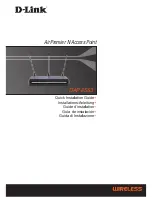
5 - 337
Additionally, a certificate can be placed on hold for a user defined period. If, for instance, a private key was found and
nobody had access to it, its status could be reinstated.
7. Provide the name of the trustpoint in question within the
Trustpoint Name
field. The name cannot exceed 32 characters.
8. Enter the resource ensuring the trustpoint’s legitimacy within the
URL
field.
9. Use the spinner control within the
Hours
field
to specify an interval (in hours) after which the access point copies a CRL
file from an external server and associates it with a trustpoint.
10. Select
OK
to save the changes and overrides made within the
Certificate Revocation
screen. Select
Reset
to revert to
the last saved configuration.
5.4.5.5.7 Overriding a Profile’s NAT Configuration
Overriding a Security Configuration
Network Address Translation
(NAT) is a technique to modify network address information within IP packet headers in transit
across a traffic routing device. This enables mapping one IP address to another to protect network address credentials. With
typical deployments, NAT is used as an IP masquerading technique to hide private IP addresses behind a single, public facing,
IP address.
NAT is a process of modifying network address information in IP packet headers while in transit across a traffic routing device
for the purpose of remapping one IP address to another. In most deployments, NAT is used in conjunction with IP masquerading
which hides RFC1918 private IP addresses behind a single public IP address.
NAT provides outbound Internet access to wired and wireless hosts. Many-to-one NAT is the most common NAT technique for
outbound Internet access. Many-to-one NAT allows the access point to translate one or more private IP addresses to a single,
public facing, IP address assigned to a 10/100/1000 Ethernet port or 3G card.
To define a NAT configuration or override that can be applied to a profile:
1. Select
Devices
from the Configuration tab.
2. Select
Device Overrides
from the Device menu to expand it into sub menu options.
3. Select a target device from the device browser in the lower, left-hand, side of the UI.
4. Select
Security
to expand its sub menu options.
5. Select
NAT.
NOTE:
A blue override icon (to the left of a parameter) defines the parameter as having
an override applied. To remove an override, go to the
Basic Configuration
screen’s
Device Overrides
field and select
Clear Overrides
. This will remove all overrides
from the device.
Summary of Contents for WiNG 5.7.1
Page 1: ...WiNG 5 7 1 ACCESS POINT SYSTEM REFERENCE GUIDE ...
Page 2: ......
Page 3: ...WING 5 7 1 ACCESS POINT SYSTEM REFERENCE GUIDE MN001977A01 Revision A April 2015 ...
Page 4: ...ii WiNG 5 7 1 Access Point System Reference Guide ...
Page 24: ...1 4 WiNG 5 7 1 Access Point System Reference Guide ...
Page 36: ...2 12 WiNG 5 7 1 Access Point System Reference Guide ...
Page 72: ...3 36 WiNG 5 7 1 Access Point System Reference Guide ...
Page 470: ...5 386 WiNG 5 7 1 Access Point System Reference Guide ...
Page 472: ...6 2 WiNG 5 7 1 Access Point System Reference Guide Figure 6 1 Configuration Wireless menu ...
Page 624: ...7 46 WiNG 5 7 1 Access Point System Reference Guide ...
Page 724: ...9 56 WiNG 5 7 1 Access Point System Reference Guide ...
Page 783: ...12 35 Figure 12 46 Device Summary screen 4 Click File Management ...
Page 816: ...12 68 WiNG 5 7 1 Access Point System Reference Guide ...
Page 1006: ...13 190 WiNG 5 7 1 Access Point System Reference Guide ...
Page 1026: ...14 20 WiNG 5 7 1 Access Point System Reference Guide ...
Page 1028: ...A 2 WiNG 5 7 1 Access Point System Reference Guide ...
Page 1089: ......
Page 1090: ...MN001977A01 Revision A April 2015 ...
















































